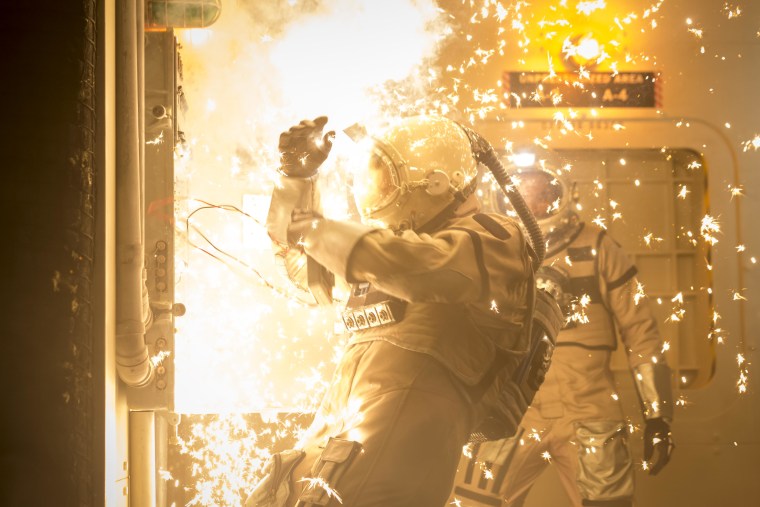A hulking spaceship the size of the Empire State Building, powered by nuclear explosions meant to carry human beings all the way to another solar system. It could never happen, right?
That was the idea behind a very real plan called Project Orion, drawn up by physicist Freeman Dyson in the late 1950s. It's also the concept behind a new SyFy show called "Ascension." The series, which premieres Monday, Dec. 15, wonders, "What if President John F. Kennedy had taken Dyson seriously and launched a giant spaceship towards another star?"
Apparently lots of sex and intrigue involving Tricia Helfer, the blond Cylon bombshell from SyFy's "Battlestar Galactica. (SyFy is owned by NBCUniversal). But it also presents a lot of thorny scientific questions that mankind might be forced to solve ... eventually.
"We couldn't do this today, let alone in 1962, which is why this is science fiction and not a documentary," David Brin, an astrophysicist and Hugo Award-winning author who consulted on "Ascension," told NBC News.
Despite the degree of difficulty, launching a generation ship — as they're called in sci-fi circles — into space might be our best chance at exploring other worlds.
"Warp drive, space-folding, wormholes — these are great dramatic devices, but if they were possible, then the galaxy should be filled with alien travelers," he said. "The advantage of a generation ship is that we might actually build one of these things"
More spaceship, more problems
On "Ascension," the ship is big ... really big. It stretches the height of the Empire State Building and weighs a healthy 100 million tons. Those dimensions come from the original plans created in the '50s, according to executive producer Phillip Levens.
"It had to be big enough so they could go to the moon, build a lunar base, have it fully manned, leave them there and go on to explore the rest of the galaxy," he told NBC News.
Building a ship like that presents a few logistical problems. First of all, there is the issue of launching something that large out of Earth's atmosphere. Brin thinks that something that massive would probably have to be built in orbit.
Then there is the matter of the engine. On the show, they use the nuclear propulsion system initially proposed by Dyson, which essentially involves setting off atomic bombs to thrust the ship forward at incredible speeds.
That would create a lot of nuclear waste and radiation, not a great mix for the people living on the ship.

There might be a better option, according to Brin. It's called inertial confinement fusion, or "pellet fusion," and it involves blasting pellets made of deuterium and tritium with lasers. It's not a pie-in-the-sky goal. Scientists at the the Lawrence Livermore National Laboratory in California announced a big breakthrough earlier this year.
But for long-distance space travel, they would have to achieve "ignition" — the point where we get more energy out of the fusion process than we put into it. That is key, Brin said, because a ship like Ascension would need also need a power source to run life support and grow food.
An engine like that would also create artificial gravity, he said, eliminating the need for a spinning structure like in "2001: A Space Odyssey."
There is also the problem of cosmic radiation and debris, both of which could end an interstellar journey dead in its tracks. To solve that problem, scientists would need to come up with some kind of electromagnetic shielding to go along with an extremely thick hull, he said.
Sex and psychology in space
Fortunately for the average viewer, "Ascension" isn't a series of scientific lectures about fusion. It's filled with human drama — which is good for ratings, but also points to a very real concern.
NASA is worried about the mental health effects of a trip to Mars, let alone to Proxima Centauri, the destination on the show. (Only 4.22 light years away, it's believed to be the closest star to our Sun).
A century is a long time to be stuck in the darkness of space with a relatively small group of people, hence the annual psychological exams that take place on the show. If somehow the passengers don't kill each other or die of starvation, radiation poisoning or their ship exploding, they still need to be healthy enough to populate a new planet.
Hence the seemingly anachronistic sight of an ethnically diverse crew.
"Even though it was the 1950s, the scientists who created the program couldn't afford to have any of the prejudices that society had," Levens said.
That is because the 350 initial passengers had to be genetically diverse to up the chance of healthier offspring, according to Levens. That doesn't mean people were pairing up like they were on some kind of interstellar "Love Boat." On "Ascension," couples are paired by their genetic compatibility, which results in 250 babies born into very awkward families.
Is "Ascension" an impossible dream?
Don't buy your ticket (or more likely, you great-grandchild's ticket) to Proxima Centauri yet. Building a spaceship capable of supporting hundreds of people for 100 years is not even remotely feasible today.
But research on the International Space Station and investment from billionaires like Jeff Bezos and Elon Musk could lead the way toward that future. The latter has already argued for putting a million people on Mars.
If we as a species decided it was a priority right now, we might be able to develop the technology for interstellar travel in a generation, according to Daniel Miller Buckland, a medical and aerospace engineering expert with degrees from MIT and Harvard.
"In terms of the human imagination, it's not that different from Columbus or the Vikings going to the New World," he told NBC News. "If that is something people want to do, humanity will probably figure out a way to do it."